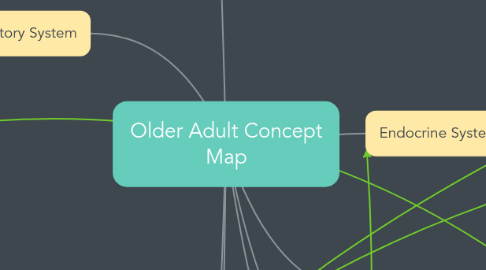
1. Reproductive System
1.1. Female
1.1.1. Physiologic Changes
1.1.1.1. Vaginal Epithelium thins
1.1.1.2. Atrophy of Sex Organs
1.1.1.2.1. Cervix
1.1.1.2.2. Fallopian Tubes
1.1.1.2.3. Uterus
1.1.1.3. Vaginal Changes
1.1.1.3.1. More alkaline
1.1.1.3.2. Shortening of canal
1.1.1.3.3. Less lubrication
1.1.1.4. Breasts Sag and Less Firm
1.1.2. Pathologic Changes
1.1.2.1. Senile vulvitis
1.1.2.1.1. Hypertrophy or Atrophy
1.1.2.2. Tumor of the Vulva
1.1.2.2.1. Fourth most common gynecological malignancy
1.1.2.3. Atrophic Vaginitis
1.1.2.3.1. Postmenopausal Women
1.1.2.3.2. Vaginal fragility
1.1.2.4. Cancer
1.1.2.4.1. Vaginal
1.1.2.4.2. Cervical
1.1.2.4.3. Endometrium
1.1.2.4.4. Ovarian
1.1.2.4.5. Breast
1.2. Male
1.2.1. Physiologic Changes
1.2.1.1. Seminal vesicles thin
1.2.1.2. Muscle tissue replaced with connective tissue
1.2.1.3. Decreased ability to retain fluids
1.2.1.4. Atrophy
1.2.1.4.1. Testes
1.2.1.5. Enlargement of prostate gland
1.2.2. Pathologic Changes
1.2.2.1. Erectile Dysfunction
1.2.2.1.1. Decreased circulation
1.2.2.1.2. Most men over 70
1.2.2.2. Benign Prostatic Hyperplasia
1.2.2.2.1. Men can be reluctant about receiving treatment
1.2.2.2.2. Most men have some form
1.2.2.3. Cancer
1.2.2.3.1. Prostate
1.2.2.3.2. Testicular
1.2.2.3.3. Scrotal
2. Respiratory System
2.1. Physiologic Changes
2.1.1. Decreased Cough Reflex
2.1.1.1. Important in removal of secretions
2.1.1.2. Promoting Productive Cough
2.1.1.2.1. Hard Candy
2.1.1.2.2. Breathing Exercises
2.1.1.2.3. Expectorants
2.1.1.2.4. Humidifier use
2.1.1.2.5. Oral Hygiene
2.1.2. Decreased Lung Size
2.1.2.1. Air capacity lowered
2.1.2.2. Decreased gas exchange
2.1.3. Decrease in alveoli elasticity
2.1.4. Decreased vital capacity
2.2. Pathologic Changes
2.2.1. COPD
2.2.1.1. Asthma
2.2.1.1.1. High rates of mortality
2.2.1.1.2. Education essential
2.2.1.1.3. High risk of cardiac issues
2.2.1.2. Bronchitis
2.2.1.2.1. Management
2.2.1.3. Emphysema
2.2.1.3.1. Usually related to smoking
2.2.1.3.2. Slow development of symptoms
2.2.1.4. Lung Cancer
2.2.1.4.1. Incidence increases over age 65
2.2.1.4.2. More men than women
2.2.1.4.3. Treatment
2.2.2. Oxygen Administration
2.2.2.1. Monitor blood gases
2.2.2.2. Oxygen use safety
2.2.2.2.1. Highly flammable
3. Gastrointestinal System
3.1. Physiologic Changes
3.1.1. Decreased Taste Sensation
3.1.1.1. Atrophy of tongue and taste buds
3.1.2. Decreased Stomach Elasticity
3.1.2.1. Less food intake at one time
3.1.3. Decrease in Pancreas Function
3.1.3.1. Decrease in fat absorption
3.1.4. Decreased Peristalsis
3.1.4.1. Constipation
3.1.5. Increased need for adequate nutrition
3.1.5.1. Vitamin requirements increase
3.1.5.1.1. B-complex
3.1.5.1.2. Vitamin E
3.1.5.1.3. Vitamin C
3.1.5.1.4. Selenium
3.1.5.1.5. Folic Acid
3.1.5.2. Cancer prevention
3.1.5.3. Nutrient absorption decreases
3.1.6. Decreased Digestive Enzyme Activity
3.1.6.1. Malnutrition
3.1.6.2. Constipation
3.2. Pathologic Changes
3.2.1. Peptic Ulcers
3.2.1.1. H. Pylori
3.2.1.2. High gastric acidity
3.2.2. Esophageal Cancer
3.2.2.1. Barrett's Esophagus
3.2.2.2. GERD
3.2.3. Xeriostomia
4. Immune System
4.1. Age Related Changes
4.1.1. Decreased Strength of Immune System
4.1.1.1. T-Cell function decline
4.1.1.1.1. Reduced response to foreign antigens
4.1.1.1.2. Decrease in cell-mediated and humoral immunity
4.1.1.2. Thymus Gland Decline
4.1.1.3. Reduced Antibody Response
4.1.2. Increased risk for infection
4.1.2.1. Chronic Conditions
4.1.2.2. Hospital acquired infections
4.1.3. Reduced thickness of skin
4.1.4. Diet
4.1.4.1. Vitamin Requirements increase
4.1.4.1.1. Vitamin A, E, C
4.1.4.1.2. B Complex
4.1.4.1.3. Folic Acid
4.1.4.1.4. Selenium
4.1.4.1.5. Zinc
4.1.4.1.6. Iron
4.1.4.2. Nutrients have large effect on immune function
4.1.4.2.1. Protein
4.1.5. Exercise
4.1.5.1. Low impact
4.1.5.2. Enhance immune function
4.2. Pathologic Changes
4.2.1. Cancer
5. Endocrine System
5.1. Physiological Changes
5.1.1. Atrophy of Thyroid Gland
5.1.2. Diminished Adrenal Function
5.1.2.1. Low epinephrine and epinephrine levels
5.1.3. Low ACTH levels
5.1.3.1. Poor hydration
5.1.4. Insulin
5.1.4.1. Low levels of insulin release
5.1.4.2. Tissue insensitivity to circulating insulin
5.2. Pathologic Changes
5.2.1. Diabetes Mellitus
5.2.1.1. Glucose Intolerance
5.2.1.2. May be asymptomatic
5.2.1.3. Tissue insensitivity to insulin
5.2.1.4. Seventh leading cause of death in older adult
5.2.1.5. Screening
5.2.1.5.1. Test more than once
5.2.1.6. Care and Management
5.2.1.6.1. Self care crucial to positive outcome
5.2.1.6.2. Education on self management vital to patient success
5.2.1.6.3. Nutrition and Exercise
5.2.1.7. Complications
5.2.1.7.1. Peripheral Vascular Disease
5.2.1.7.2. Diabetic retinopathy
5.2.1.7.3. Coronary Artery Disease
5.2.1.7.4. Urinary Tract infections
5.2.1.7.5. Cognitive Impairment
5.2.2. Hypothyroidism
5.2.2.1. Aging thyroid gland
5.2.2.2. Signs and Symptoms
5.2.2.2.1. Lethargy
5.2.2.2.2. Excessive Sleep
5.2.2.2.3. Weight Gain
5.2.3. Hyperthyroidism
5.2.3.1. Less prevalent in older adults
5.2.3.2. Too much thyroid hormone excreted
5.2.3.3. Signs and symptoms
5.2.3.3.1. Tremors
5.2.3.3.2. Jitteriness
5.2.3.3.3. Weight Loss
6. Cardiovascular System
6.1. Physiological Changes
6.1.1. Less Efficient Myocardial Muscle
6.1.1.1. Decrease contractile strength
6.1.1.2. Decreased Cardiac Output
6.1.2. Cardiac Output Demands Increase
6.1.2.1. Increased need for exercise
6.1.2.2. Increased need for adequate nutrition
6.1.3. Stiffening of Valves
6.1.3.1. "Wear and Tear"
6.1.4. Slower Cardiac Nervous Response
6.2. Pathologic Changes
6.2.1. Stroke
6.2.1.1. Atherosclerosis
6.2.1.1.1. Buildup of plaque around arteries
6.2.1.2. Arteriosclerosis
6.2.1.3. Hypertension
6.2.1.3.1. Alteration of lifestyle
6.2.1.3.2. Systolic over 140
6.2.1.3.3. Diastolic over 90
6.2.1.3.4. Stress, anxiety
6.2.2. Increased Risk of Diabetes
6.2.2.1. Weakened pancreas
6.2.2.2. Insulin insensitivity
6.2.3. Pulmonary Emboli
6.2.3.1. Increase cholesterol and clotting factors in blood
6.2.4. Hyperlipidemia
6.2.4.1. Family history
6.2.4.2. Evaluate triglycerides, lipids, lipoproteins
6.2.5. Congestive Heart Failure
6.2.5.1. Leading cause of hospitalization in older adults
6.2.5.2. Complication of atherosclerosis
6.2.5.3. CAD
6.2.6. At Risk Behaviors
6.2.6.1. Smoking
6.2.6.1.1. Increases risk of cardiovascular event significantly
6.2.6.2. Alcohol Use
6.2.6.2.1. Can be beneficial in small doses
6.2.7. Heart Disease
6.2.7.1. Education is critical
6.2.7.2. Prevalence increases with age
6.2.7.3. Men and women exhibit difference signs
7. Urinary System
7.1. Physiologic Changes
7.1.1. Thickening of Bladder
7.1.1.1. Hypertrophy
7.1.1.2. Decreases ability to expand
7.1.1.2.1. Less storage space
7.1.1.2.2. Nocturia
7.1.2. Increase in urinary frequency
7.1.3. Weak bladder muscles
7.1.4. Urinary Retention
7.1.5. Decreased Kidney filtration
7.1.5.1. Cannot process drugs
7.1.5.1.1. Adverse drug reactions
7.1.5.2. High blood urea nitrogen levels
7.1.6. Decreased tubular function
7.2. Pathologic Changes
7.2.1. Urinary Incontinence
7.2.1.1. Embarrassing and problem some
7.2.1.2. Age related changes impact prevalence
7.2.1.3. Types
7.2.1.3.1. Stress
7.2.1.3.2. Overflow
7.2.1.3.3. Urgency
7.2.1.3.4. Function
7.2.1.3.5. Neurogenic
7.2.1.3.6. Mixed
7.2.1.4. Cognition
7.2.1.5. Identify cause and treat accordingly
7.2.2. Cancer
7.2.2.1. Bladder
7.2.2.1.1. Blood in urine
7.2.2.1.2. Painless
7.2.3. Renal Calculi
7.2.3.1. Calcium buildup in kidneys
7.2.3.1.1. Decreased kidney filtration
7.2.3.1.2. Potential infection
7.2.3.1.3. Decreased absorption of vitamins and minerals
7.2.4. Glomerulonephritis
7.2.4.1. Acute
7.2.4.1.1. Sudden onset
7.2.4.1.2. Infection based
7.2.4.2. Chronic
7.2.4.2.1. Repeated over time
8. Nervous System
8.1. Sensory
8.2. Cognition
8.2.1. Pathologic Changes
8.2.1.1. Dementia
8.2.1.1.1. Progressive
8.2.1.1.2. Irreversible
8.2.1.1.3. Impaired cognitive function
8.2.1.2. Alzheimer's Disease
8.2.1.2.1. Common form of dementia
8.2.1.2.2. Brain Changes
8.2.1.2.3. Causes
